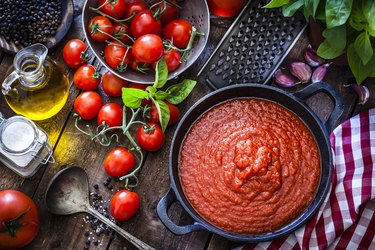
Is your tomato sauce too sweet? Tone it down with the addition of lemon juice or vinegar. Reduce spiciness by adding coconut milk.
Tip
Neutralize sugar in a tomato sauce with lemon juice or vinegar.
Video of the Day
Tomato Sauce Too Sweet?
In an interview with LIVESTRONG.com_,_ Lisa Richards, CNC, nutritionist and creator of The Candida Diet, shares advice on how to tone down sauces that are too sweet or spicy.
Video of the Day
According to Richards, store-bought sauces have flavors that don't appeal to everyone's tastes. "A sweet sauce can be overly sweet, and the spiciness can be too much for the tolerance of some," she says. Toning these flavors down is fairly simple, but take care not to add extra salt or sugar to the base.
Is your enchilada sauce too sweet? "To reduce the sweetness, add vinegar or lemon juice, 1 teaspoon at a time, while heating the sauce," Richards notes. One way to tone down spiciness without adding sugar is to add coconut milk.
The tomato flavor of some sauces can be too intense. Add cooked mushrooms to a tomato sauce to calm down this flavor. "Mushrooms have a type of taste called umami, which is a little known food flavor, compared to sweet, salty, sour, and bitter. It's very earthy and effective in toning down many acidic foods," Richards states.
How to Change Recipes
Aside from modifying store-bought foods, you can decrease the sweetness and saltiness of dishes easily when you cook at home. Reduce the amount of sugar in a recipe by one-half or one-third, and you'll likely never notice that the end product isn't as sweet.
Mayo Clinic suggests adding vanilla and almond extracts, as well as nutmeg, cinnamon, cloves and allspice, to impart sweetness. To increase the perception of sweetness, double the amount of cinnamon or vanilla listed in a recipe.
Read More: 5 Easy Ways to Cut Down on Sugar
MedlinePlus says to substitute unsweetened applesauce for sugar in recipes. Also, instead of adding sugar to oatmeal, mix in ginger or similar spices.
Likewise, cut the quantity of salt in half when preparing salads or cooking soups and main dishes, the Mayo Clinic advises. Halve the quantity of salt in recipes for baked goods that don't call for yeast. For recipes with yeast, reducing salt may not be as feasible, because some salt is needed for the leavening action of the yeast to work properly.
Read More: What Do Sugar and Salt Do to Your Body?
How to Add Flavor
It's possible to boost the flavor of foods with certain cooking techniques, states the American Academy of Nutrition and Dietetics (AND). Store food properly, because poor storage affects flavor. Another mistake that reduces flavor and nutrients is overcooking, so prepare food in such a way as to preserve taste, texture and visual appeal.
For a vegetable dish with a sweet, smoky flavor, brush vegetables with oil, sprinkle with herbs and roast in a very hot oven. Red, yellow and green peppers, along with hot sauce, add great flavor to dishes. Experiment with high-quality condiments such as salsa, flavored mustard or horseradish, to add pleasing zing.
Small amounts of bold flavors, such as cilantro or chipotle pepper, can bring a dish to new heights. The acid taste in grated citrus peel or citrus juice can balance flavors, says the AND.
For poultry, meat and fish, high-temperature cooking methods like grilling or broiling intensify flavor, but be careful not to over-brown food. Another tip for enhancing meat dishes is to caramelize onions to use in a rich sauce.
To make spaghetti sauce more savory, put in fresh-chopped onions and garlic. Fresh herbs, such as basil, can impart more flavor than dried herbs.